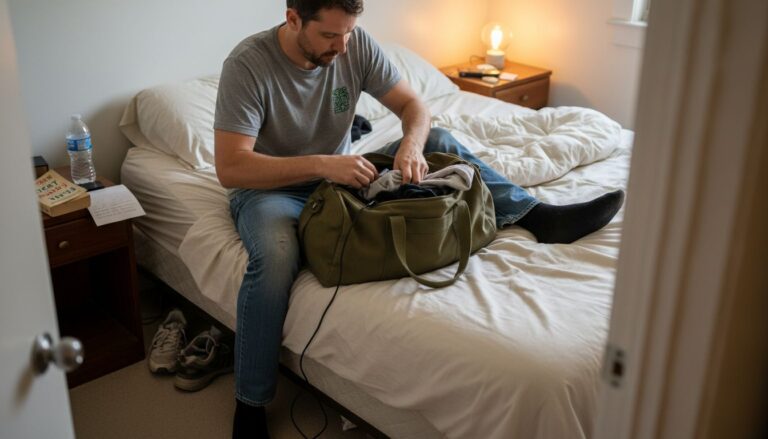Over 21 million Americans struggle with addiction, but less than 10 percent receive treatment each year. For many, the hardest part is figuring out the rehab admission process and understanding insurance coverage. Getting organized with the right documents and knowing what to ask about your insurance plan can save time and reduce stress. Taking these simple steps helps you access the care you need and avoid surprise costs along the way.
Table of Contents
- Step 1: Gather Necessary Personal and Insurance Information
- Step 2: Verify Rehab Coverage with Your Insurance Provider
- Step 3: Request Pre-Authorization for Rehab Services
- Step 4: Review In-Network and Out-of-Network Rehab Options
- Step 5: Finalize Admission and Monitor Benefits Usage
Quick Summary
| Key Point | Explanation |
|---|---|
| 1. Gather essential personal documents | Collect identification, Social Security, and insurance cards to streamline the admission process at the rehab center. |
| 2. Verify insurance coverage details | Contact your insurance provider to understand the specifics of your rehabilitation treatment coverage and minimize financial surprises. |
| 3. Request pre-authorization for treatments | Ensure your insurance covers the proposed treatment plan by obtaining pre-authorization, which helps avoid unexpected costs. |
| 4. Compare in-network versus out-of-network facilities | Evaluate both options to balance treatment quality with potential costs; in-network facilities usually lower out-of-pocket expenses. |
| 5. Finalize admission and track benefits | Complete necessary forms on admission day and keep a careful record of insurance benefits to manage treatment costs effectively. |
Step 1: Gather Necessary Personal and Insurance Information
Before you walk through the doors of a rehabilitation center, you will need to organize your personal and insurance documents. This preparation streamlines your admission process and helps reduce stress during an already challenging time.
Start by collecting your core identification documents. You will want to locate your government issued photo ID like a drivers license or passport. According to research from Plymouth House, a valid photo ID is crucial for verification during admission.
Next, gather your Social Security card and birth certificate. These documents help establish your identity and are often required during the intake process. Insurance cards are equally important. Make sure you have your current health insurance card and understand the details of your policy coverage.
Pro Tip: Create a dedicated folder or digital scan of these documents to keep everything organized and easily accessible.
Additionally, you will want to have proof of current address such as a utility bill or lease agreement. As research from Immersion Recovery suggests, having these documents ready can significantly expedite your rehabilitation center intake.
Once you have collected these materials, you will be well prepared for the next steps in your recovery journey. The admission team will help guide you through any additional documentation requirements.
Contact our admissions team if you need assistance preparing your documents or have questions about the admission process.
Step 2: Verify Rehab Coverage with Your Insurance Provider
Understanding your insurance coverage for rehabilitation treatment is a critical step in accessing the care you need. This process will help you determine what services are covered and minimize unexpected financial expenses.
Begin by locating the customer service number on the back of your insurance card. According to Solutions Recovery, you should contact your insurance provider directly to discuss substance abuse treatment coverage.
When speaking with your insurance representative, ask specific questions about your coverage. Research from The Healthier Choice Recovery indicates that in Los Angeles, insurance providers typically cover various types of treatment through private insurance and Medi-Cal.
Pro Tip: Take detailed notes during your call and request written confirmation of your coverage to avoid misunderstandings.
Specifically, inquire about these key details:
- Types of rehabilitation treatments covered
- Duration of coverage
- Required copayments or out of pocket expenses
- Whether preauthorization is needed
- In network or out of network treatment options
If you encounter challenges understanding your coverage, consider asking a family member or trusted friend to help you navigate the process. Many insurance representatives can provide clear explanations of your benefits.
Once you understand your coverage, you will be prepared to discuss treatment options with rehabilitation centers. This knowledge empowers you to make informed decisions about your recovery journey.
Contact our admissions team if you need additional guidance understanding your insurance coverage.
Step 3: Request Pre-Authorization for Rehab Services
Pre-authorization is a crucial step in your rehabilitation journey that ensures your insurance will cover the treatment services you need. This process helps you avoid unexpected medical expenses and confirms your treatment plan meets your insurance provider’s requirements.
According to Solutions Recovery, pre-authorization involves getting your insurance company to approve your treatment plan before you begin services. This step is essential for confirming coverage and preventing potential financial surprises.
To start the pre-authorization process, you will need to work closely with both your chosen rehabilitation center and your insurance provider. The Healthier Choice Recovery recommends confirming whether pre-authorization is required for specific treatments like medical detox, partial hospitalization, or residential rehabilitation.
Pro Tip: Request that your rehabilitation center help you compile the necessary medical documentation for the pre-authorization request.
Gather these critical documents before initiating the pre-authorization request:
- Detailed treatment plan from your rehabilitation center
- Medical records documenting your need for treatment
- Physician recommendations
- Specific rehabilitation program details
Your rehabilitation center’s admission team can often assist you in communicating with your insurance provider. They understand the technical requirements and can help streamline the pre-authorization process.
Be prepared to provide additional information if requested. Insurance companies might require more details about your specific treatment needs to approve coverage.
Contact our admissions team if you need support navigating the pre-authorization process or have questions about insurance documentation.
Step 4: Review In-Network and Out-of-Network Rehab Options
Understanding the difference between in-network and out-of-network rehabilitation facilities can significantly impact your treatment costs and overall recovery journey. This step will help you make an informed decision that balances quality care with financial considerations.
According to Solutions Recovery, in-network facilities have established agreements with your insurance provider, which typically means lower out-of-pocket expenses for you. These facilities have pre-negotiated rates that can substantially reduce your financial burden.
The Healthier Choice Recovery highlights that Los Angeles rehab centers offer various network options. When reviewing facilities, contact your insurance provider to get a current list of in-network rehabilitation centers in your area.
Pro Tip: Ask your insurance representative about the specific cost differences between in-network and out-of-network treatment options.
Key factors to consider when evaluating network status include:
Here’s a comparison of in-network and out-of-network rehab facility features:
| Feature | In-Network Facility | Out-of-Network Facility |
|---|---|---|
| Coverage Percentage | Higher Typically 60-90% |
Lower May be 0-60% |
| Out-of-Pocket Costs | Lower Copays/coinsurance |
Higher Deductible applies |
| Pre-Negotiated Rates | Yes | No |
| Insurance Approval Needed | Easier process | Often more paperwork |
| Access to Specialized Programs | May be limited | Wider selection possible |
| Proximity Options | Usually local network | May require travel |
- Percentage of treatment costs covered
- Your potential out-of-pocket expenses
- Quality of care and treatment approach
- Proximity to your home or work
- Specialized programs that meet your specific needs
While in-network facilities are often more affordable, sometimes an out-of-network center might offer specialized treatment that better suits your unique recovery needs. In such cases, the additional cost might be worth the investment in your long-term health.
If you are considering outpatient programs that offer flexibility, understanding your network options becomes even more critical. Some outpatient services might have different network classifications compared to residential treatments.
Contact our admissions team if you need help navigating your insurance network and finding the most suitable rehabilitation option.
Step 5: Finalize Admission and Monitor Benefits Usage
The final stage of your rehabilitation journey involves completing the admission process and carefully tracking your insurance benefits. This critical step ensures a smooth transition into treatment and helps you manage potential financial considerations.
According to Methadone.org, your admission day will involve completing comprehensive administrative forms. These documents will capture essential information about your personal history, medical background, and specific substance use details that will help shape your personalized treatment plan.
American Addiction Centers emphasize the importance of monitoring your insurance benefits throughout your treatment. Keeping close track of your coverage can prevent unexpected financial surprises and ensure continuous care.
Pro Tip: Create a dedicated folder to store all admission documents, insurance communications, and treatment records.
Key actions during the admission process include:
- Providing accurate medical history
- Completing consent and confidentiality forms
- Discussing treatment expectations with your care team
- Reviewing financial responsibilities
- Confirming insurance coverage details
If you are interested in understanding the advantages of outpatient programs, discuss these options during your admission consultation. Different program types might have varying insurance coverage requirements.
Regularly communicate with both your treatment center and insurance provider to stay informed about your benefits usage. This proactive approach helps you understand your remaining coverage and potential out-of-pocket expenses.
Contact our admissions team if you need assistance navigating the final stages of admission or have questions about tracking your insurance benefits.
Simplify Your Rehab Insurance Journey with Glendora Recovery Center
Navigating insurance coverage for rehabilitation in Los Angeles can feel overwhelming and full of uncertainty. From gathering essential documents and verifying your policy benefits to securing pre-authorization and choosing between in-network and out-of-network options the process demands clarity and support. If you are concerned about unexpected costs, complex paperwork, or how to make the best insurance decisions for your recovery goals you are not alone.
At Glendora Recovery Center we understand these challenges and stand ready to guide you every step of the way. Our expert admissions team specializes in helping you organize your insurance information, clarify your coverage details, and simplify pre-authorization. We tailor treatment plans to fit your needs while ensuring you maximize your benefits. Take control of your recovery journey confidently by connecting with professionals who care about your peace of mind.
Ready to remove the confusion from your rehab admission process and start your path to healing without delay? Reach out to our friendly team today via Contact our admissions team and discover how we can help you navigate insurance smoothly. Don’t wait until paperwork and insurance questions hold you back. Visit Glendora Recovery Center now and take the decisive step towards comprehensive addiction treatment with trusted support.
Frequently Asked Questions
How can I verify my insurance coverage for rehab in Los Angeles?
To verify your insurance coverage for rehab, call the customer service number on the back of your insurance card. Ask specific questions about what types of treatments are covered and any required out-of-pocket expenses.
What documents do I need to gather before seeking rehab?
Before seeking rehab, gather your government-issued photo ID, Social Security card, birth certificate, insurance card, and proof of current address. Organize these documents in a folder to ensure a smoother admission process.
Is pre-authorization required for rehab services?
Pre-authorization is often required for many rehab services, especially for types like medical detox or residential treatment. Contact your insurance provider to check if this approval is necessary and what specific documents you’ll need to provide.
What is the difference between in-network and out-of-network rehab facilities?
In-network rehab facilities typically offer lower out-of-pocket costs due to pre-negotiated rates with your insurance provider, while out-of-network facilities may charge higher fees without guaranteed coverage. Evaluate your options considering the costs and available programs to find the best fit for your needs.
How do I monitor my insurance benefits during rehab?
To monitor your insurance benefits, keep a dedicated folder containing all admission documents, insurance communications, and treatment records. Regularly check in with your treatment center and insurance provider about your remaining coverage and any potential expenses to avoid surprises.
What should I discuss with my insurance provider before starting rehab?
Before starting rehab, discuss coverage specifics with your insurance provider. Inquire about the types of treatments covered, the percentage of costs they will pay, and any necessary approvals to avoid unexpected expenses during your treatment journey.




